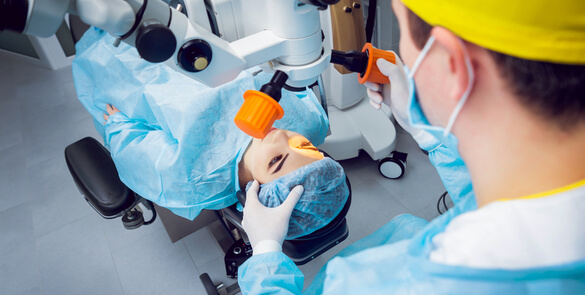Presbyopia is a vision condition which makes it difficult to focus on close objects. During middle age, usually beginning in the 40s, people experience blurred vision at near points, such as when reading, sewing or working at the computer. Presbyopia is a natural part of the ageing process of the eye. It is not a… Continue reading Presbyopia
What is Posterior Vitreous Detachment? Causes, Symptoms & Care
PVD is a common degenerative change, which affects one or both eyes in many people after middle age. It may present earlier in shortsighted patients or those who have sustained traumas to the eyes. Thickening of the jelly casts shadows on the retina and are seen as floating shapes. These black “floaters”in your vision move… Continue reading What is Posterior Vitreous Detachment? Causes, Symptoms & Care
Post-Operative Instructions
Following Retinal Surgery on leaving the hospital you are advised to have a quiet evening at home and to avoid strenuous exercise. For General Anaesthetic patients, as above and: Do not drive a vehicle Do not make any crucial financial decision Do not eat heavy meals or drink alcohol for 24 hours after being discharged
Myopia
Myopia is a common refractive condition which causes individuals to be near-sighted: they see near objects clearly but distant objects are blurry. Myopia occurs when the cornea and lens focus the light in front of the retina instead of exactly on it. Symptoms of myopia include; difficulty seeing distant objects, squinting frequently, holding books or… Continue reading Myopia
Hypermetropia
A refractive condition of the eye in which vision is better for distant objects than for near objects. It can be called far sightedness or hypermetropia. Symptoms of Hypermetropia can include; blurred vision, asthenopia (eye strain), accommodative dysfunction, binocular dysfunction, amblyopia and strabismus. It results from the eyeball being smaller than average, causing images to… Continue reading Hypermetropia
High Precision Refractive Surgery
When you decide on an eye laser treatment, you expect the best possible results. The more fully developed the methods are, the better the outcome will be. The SCHWIND AMARIS 750S offers you the leading technology for your laser treatment – superior in all important aspects: Speed, precision, safety and comfort.
Types of Diabetic Retinopathy
Introduction Diabetic retinopathy is a complication of diabetes and leads to high blood sugar, resulting in retinal disease, which can interfere with its ability to transmit images to the brain through the optic nerve. Blood vessels in the retina play an important role in supplying it with oxygen and nutrients, which keep it healthy and… Continue reading Types of Diabetic Retinopathy
Dacryocystorhinostomy
[:en]Blocked Tear Duct. The tear ducts start at the inner corner of the eye with two small holes in the corner of the eyelids. Each hole is known as a punctum, they lead into small tubes known as canaliculi, which in turn drains into the lacrinal sac. This lies between the corner of your eye… Continue reading Dacryocystorhinostomy
Ophthalmologist
[:en]Patients who need further specialist treatments for their eyes go to an Ophthalmologist. An Ophthalmologist is a medical doctor who specialises in the medical and surgical care of the eyes, visual system and in the prevention of eye diseases and injuries. They provide the full range of care including routine eye examinations, diagnosis and treatment… Continue reading Ophthalmologist
Orthoptist
[:en]Children who need to see an eye Specialist will initially go for a review with an Orthoptist – a health professional who specialises in eye movement problems and disorders that affect how the eyes work together. These conditions are typically diagnosed in childhood; so Orthoptists are highly experienced in examining children of all ages and… Continue reading Orthoptist
Low Vision Aids
[:en]Where good vision cannot be achieved with spectacles or contact lenses, patients can be assessed in our low vision clinic. During a low vision assessment, one of our optometrists will perform an examination to identify any refractive errors (problems with focusing) and demonstrate low vision devices such as specialist spectacles, magnifiers or telescopes that could… Continue reading Low Vision Aids
Anti-angiogenic (anti-VEGF) drugs
[:en]This treatment involves having an injection into your eye to treat certain retinal conditions that cause abnormal blood vessels to grow and leak under the retina. Patients with these conditions can lose central vision when abnormal blood vessels bleed under the retina at the back of the eye. A series of injections of anti-VEGF medicines… Continue reading Anti-angiogenic (anti-VEGF) drugs






